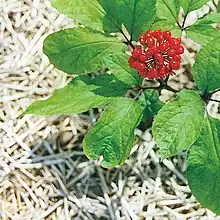Panax ginseng
Panax ginseng, ginseng,[2] also known as Asian ginseng,[2][3] Chinese ginseng,[2][3] Japanese gingseng or Korean ginseng,[2][3][4] is a species of plant whose root is the original source of ginseng. It is a perennial plant that grows in the mountains of East Asia.
| Panax ginseng | |
|---|---|
 | |
| Scientific classification | |
| Kingdom: | Plantae |
| Clade: | Tracheophytes |
| Clade: | Angiosperms |
| Clade: | Eudicots |
| Clade: | Asterids |
| Order: | Apiales |
| Family: | Araliaceae |
| Genus: | Panax |
| Species: | P. ginseng |
| Binomial name | |
| Panax ginseng | |
| Synonyms[1] | |
Names
Panax ginseng is called Rénshēn (人蔘 or 人参 or 人參; lit. 'ginseng') in Mandarin (Chinese), Insam (인삼; 人蔘) in Korean and Ninjin (人参) in Japanese.
Description
Panax ginseng is a herbaceous perennial growing from 30 to 60 cm tall. Plants have a spindle- or cylinder-shaped taproot, usually with 1 or 2 main branches. Plants produce 3 to 6 leaves that are palmately compound, with each leaf having 3 to 5 leaflets. The margins of the leaflets are densely serrated. The flowers are born in a solitary inflorescence that is a terminal umbel with 30 to 50 flowers. The peduncles of the flowers are 15 to 30 cm long. The flower ovary is 2-carpellate, with each carpel having two distinct styles. Mature fruits are 4–5 x 6–7 millimeters in size, red in color, and round with flattened ends. The white seeds are kidney-shaped. The (2n) diploid chromosome count is 48.[5]
Distribution
Panax ginseng is native to mountainous regions of Russian Manchuria (in the Russian Far East), Manchuria, Northeast China, and the Korean Peninsula.[2] It is a protected plant in Russia and China, and most commercial ginseng is now sourced from plants cultivated in China, Korea and Russia. It is also cultivated in some areas of Japan. The plant is a slow-growing perennial, and the roots are usually harvested when the plants are five or six years old.[6]
Cultivation
Panax ginseng is one of the most commonly cultivated ginseng species, along with P. notoginseng (found naturally in China) and P. quinquefolius.[7]
Research
There is no high-quality evidence for ginseng having a health effect.[8] Ginseng phytochemicals called ginsenosides are under preliminary research for their potential to affect fatigue in people with multiple sclerosis.[8] Panax ginseng is generally considered safe for adults when used for less than six months, but may be unsafe to use for longer than six months.
Folk medicine
Ginseng is used as an herb in folk medicine.[3] It is consumed due to the belief that it may improve memory and cognition in otherwise healthy adults[3] and that it may improve sexual function in adults with erectile dysfunction.[8]
See also
References
- Synonyms in Catalogue of life
- "Panax ginseng". Germplasm Resources Information Network. Agricultural Research Service, United States Department of Agriculture. Retrieved 13 February 2018.
- "Asian Ginseng". National Center for Complementary and Integrative Health (NCCIH). September 2016. Retrieved June 24, 2017.
- English Names for Korean Native Plants (PDF). Pocheon: Korea National Arboretum. 2015. p. 559. ISBN 978-89-97450-98-5. Archived from the original (PDF) on 25 May 2017. Retrieved 24 December 2016 – via Korea Forest Service.
- "Panax ginseng in Flora of China @ efloras.org". www.efloras.org. Retrieved 2022-12-05.
- Mahady, Gail B.; Fong, Harry H.S.; Farnsworth, N.R. (2001). Botanical Dietary Supplements. CRC Press. pp. 207–215. ISBN 978-90-265-1855-3.
- Baeg, In-Ho; So, Seung-Ho (2013). "The world ginseng market and the ginseng". Journal of Ginseng Research. 37 (1): 1–7. doi:10.5142/jgr.2013.37.1. PMC 3659626. PMID 23717152. Retrieved 11 August 2018.
- "Panax ginseng". MedlinePlus, US National Library of Medicine. 21 April 2021. Retrieved 24 August 2021.